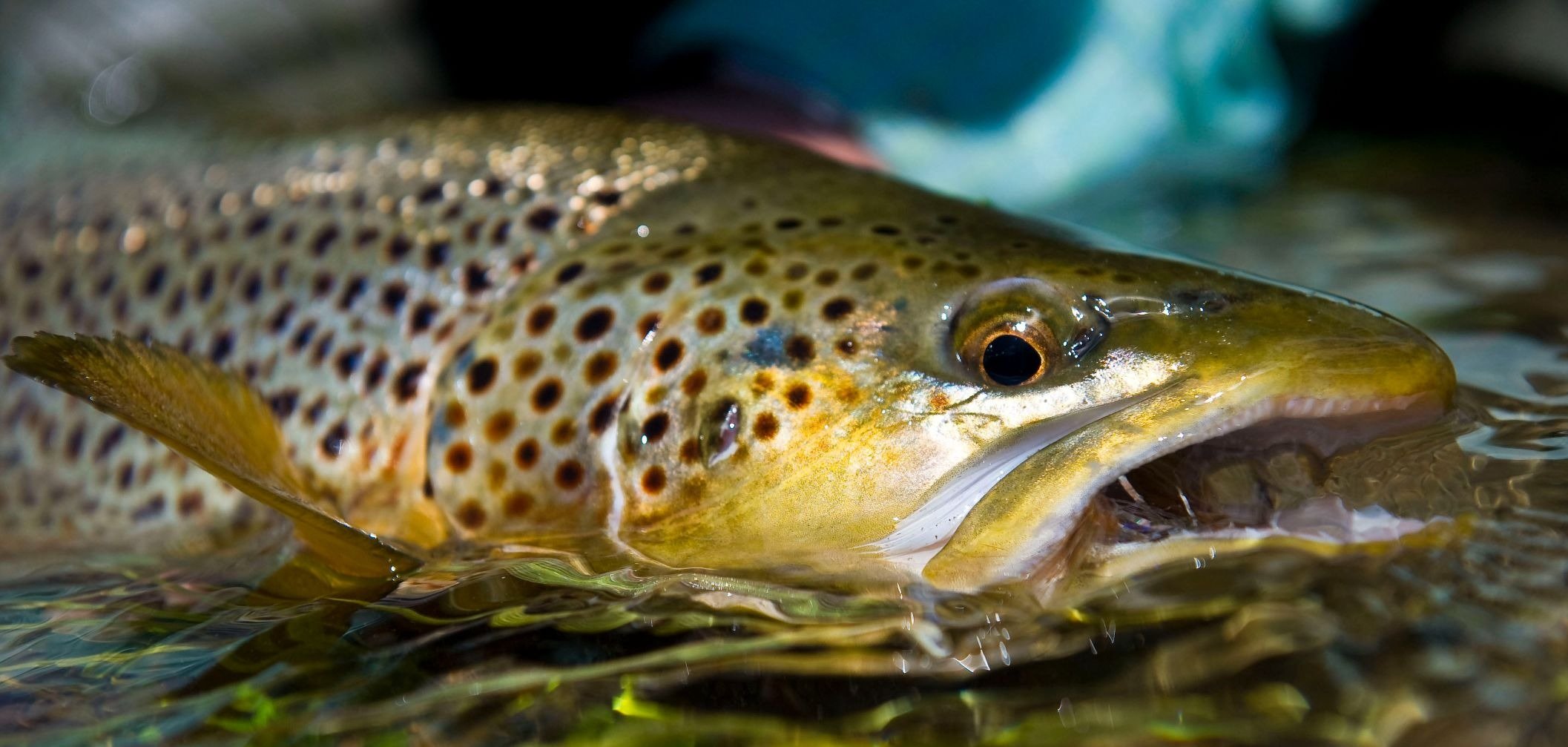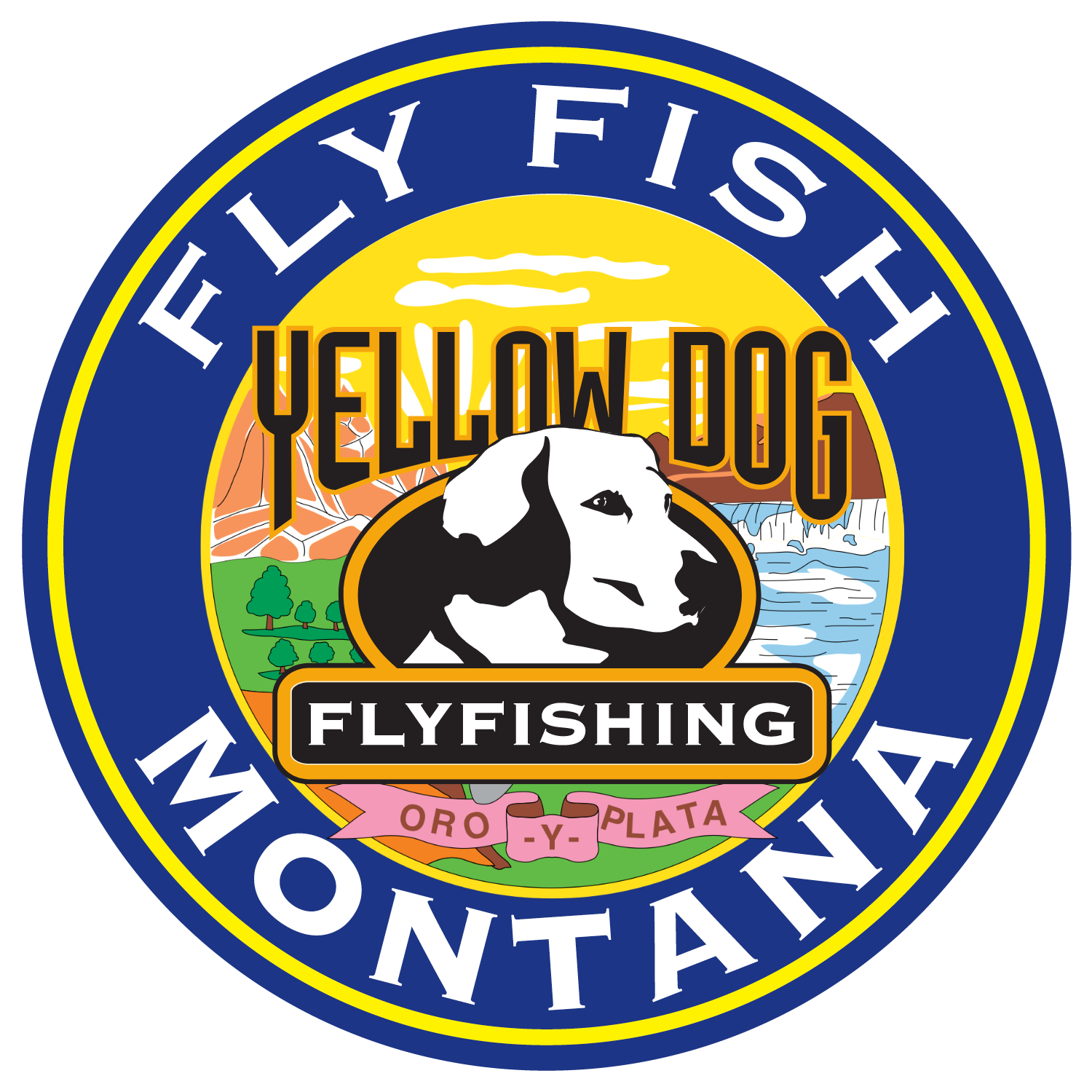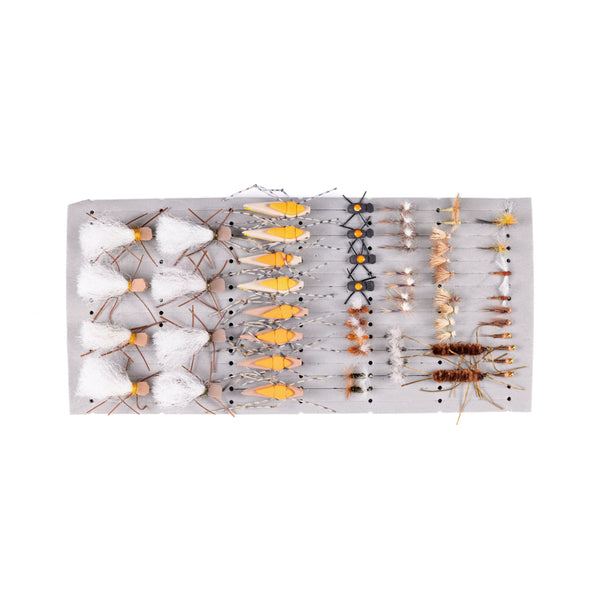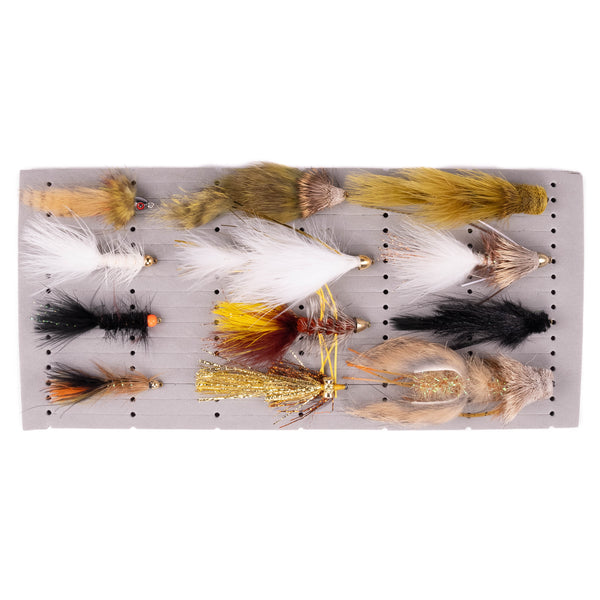The lower Madison River is considered to be the Madison River from below Ennis Lake, downstream to the headwaters of the Missouri River. This section of the Madison flows through the Bear Trap Wilderness Area in a narrow gorge characterized by some serious whitewater and difficult access. Once the river leaves the Bear Trap Canyon, it dramatically changes character, becoming wider with a seemingly gentle flow all the way to Three Forks, where it joins the Jefferson River and Gallatin River to form the Missouri River.
The river is only 20 minutes from our Bozeman fly shop and works well for both floating and wading guided fly fishing trips. We offer both full and half-day guided fly fishing trips on the Lower Madison. Notoriously tough to figure out, this is one river in the area where having an experienced guide at your side or on the oars really makes the difference between catching a few fish and having a fantastic day.
When to Fly FIsh the Lower Madison
The Lower Madison is a year-round fishery that typically fishes well in various water conditions and stream flows. Because it flows out of Ennis Lake, the river is less affected by the spring runoff than other local rivers like the Yellowstone and Gallatin. The river will typically be in pretty poor shape for 2-3 weeks each year in late May and early June but still remains fishable to some degree. Outside of the spring melt, the river stays in fine shape the rest of the year with a few exceptions, as Ennis Lake turns over in the spring and fall.
Once the summer heat arrives and flows coming out of Ennis Lake stabilize – usually sometime in July – the Lower Madison goes through some dramatic daily temperature changes. As water temperatures approach and exceed 70 degrees, trout become physiologically stressed, so we start fishing around sunrise and are typically off the water by 2 pm. Also, the warm water temperatures cause the aquatic vegetation to “grow like weeds,” which can sometimes make fishing challenging. If you don’t mind learning how to cope with casting around the weeds and getting on the water while the sun is coming up, the lower Madison is a great choice all year round. This stretch of the river often goes on “Hoot Owl” restrictions for most of July and August, which means it is open to fishing from midnight to 2 pm. It is often a great choice during this time of year as the angling pressure is minimal, and we can be off the water before the summer heat really starts to hit.
Highlights of Fishing the Lower Madison
Winter dry fly fishing on the lower is classic “match the hatch” midge and Baetis dry fly fishing at its best. Give us a few clouds and a wisp of a breeze any day in February or March, and we’ll be over on the lower hunting for big head coming up to little dries in skinny water. It’s just one of those things that happen on the lower every year that gets everyone around here excited to get on the water. If the wind is blowing and the insects aren’t out, the nymphing is always great this time of year too.
The Mother’s Day Caddis hatch on the lower Madison is characterized by a mass emergence of insects daily that usually goes on for a few weeks. Unlike the Yellowstone, this particular stretch of the Madison typically remains fishable throughout the peak periods of the hatch. The dry fly fishing can be excellent on the lower Madison during the hatch, but the best fishing is typically had on warm, cloudy days and during the last few hours of daylight.
Early summer on the lower Madison is the best time of year to find the big browns that live throughout the lower Madison. This is the time of year when water temperatures are ideal for keeping the fish feeding throughout the day, water levels keep the larger fish spread out throughout the river, and the weeds are not an issue. We’ll be looking primarily for big Browns in the 20”-25” range this time that are looking for slow-moving crayfish and sculpin patterns fished under an indicator.
Many of the big Browns seem to disappear once the heat of the summer gets here but are found once again as the days get shorter and the nights cooler. Usually, by mid-September, we will be fishing the lower every day with large, lightly weighted streamers over the shallow weed beds in the hope of finding a few large fish. This is always a great time of year to be on the lower Madison and is a great example of what Montana fly fishing can be like during the fall.
Sections of the Lower Madison
Bear Trap Canyon
Leaving Ennis Lake begins the Bear Trap Canyon section, and the steep rocky cliffs, fast gradient, and difficult wading will make you feel like you’re in a different world than the river upstream. With only two public access points, anglers that put on the boot miles are rewarded with a river void of people yet full of hungry trout. Wading in spots can be pretty precarious, and sturdy wading boots with studs and wading staffs are recommended. The river also boasts a large population of crayfish that the fish are keyed in all year. Dead drift nymphing, twitch, or swinging crayfish imitations is always a go-to here.
The Lower Madison
The last section of the Madison before its confluence with the Missouri River is what locals call “The Lower.” Providing a shoulder season fishery, The Lower gets too warm in the summer months to safely and ethically fish for trout. Prime months here are March through late June and again from mid-September to November. With the wind isn’t howling, you will find incredible BWO hatches in the winter months. Coinciding with Mothers Day, The Lower will receive what some will call blanket caddis hatches – hatches so thick a buff is required to keep the bugs out of your ears, nose, and mouth. It can be quite a spectacle when you hit it just right! Below the Greycliff fishing access, trout numbers begin to dwindle due to more extended periods of warm water, but the size of these fish, on average, can be trophy quality. Fishing this low is not a numbers game, but it can give up the fish of the season for the lucky angler putting the time in.
Seasons on the Madison River
All rivers fish best during certain seasons, and the Madison River is no exception. Considered to be a year-round fishery, you can experience various hatches, scenery, and even fishing techniques given the time of year you decide to fish. The Madison fishes consistently with nymphs, dry flies, or streamers from fast riffles, undercut banks, or deep and slow pools.
Spring
Spring brings pre-spawn rainbow trout in the river that moves up from Ennis Lake to perform their yearly ritual. You can find some of the largest and feistiest fish of the year during March and April. Runoff tends to be short and sweet on the Madison, which rarely affects fishing for more than a week or two. Once the water begins to warm, the annual caddis hatch in early to mid-May kicks off the dry fly season, signaling an end to the long Montana spring. The wind is no stranger to the Madison valley in the spring months, and the stray snow squall can appear out of nowhere. It’s best to pack accordingly with an insulated jacket, waders, beanie, and gloves.
It’s important to note that early spring means it’s time for the rainbow trout spawning season. You will find redds on almost all of the shallow gravel bars throughout the river system. It’s best to keep an eye out for this and to avoid it to the best of your ability at all times. Please leave these fish alone and continue the yearly ritual of producing trout for years to come.
Summer
As water temps continue to rise, bug and hatch activity increases exponentially. Caddis continue to be a staple food source for trout, and the PMD’s begin to make their appearance in mid to late June. Salmon flies steal the show on the Madison in late June or early July (water temp dependent) – bringing the largest fish in the river to eat your dry fly. Casting these large flies against the bank from a Mckenzie-style drift boat is undoubtedly the most popular form of summer transport on the Madison – especially when searching for fish with these large stonefly dries. However, to truly take advantage of the incredible dry fly fishing, getting out of the boat and wading the banks is the ticket. Be sure to wear sturdy wading boots and even use a wading staff – the boulders of the Madison are pretty unforgiving!
Fall
By September, the large stoneflies have completed their yearly flights, the caddis are dwindling daily, and the summer crowds of anglers are headed back home for the winter. This leaves the Madison valley quiet, and the brown trout hungry as the water temps drop. Fish know a long winter is coming, and they are ready to pack on the calories. Blue Wing Olives (BWO’s) make their appearance on the upper river on cloudy and calm days – sometimes in blanket hatches. This will bring every fish in the river up and feed on these bugs. Fall is also the time to search out that trophy brown trout with streamers. Large, dark, and articulated streamers fished on an intermediate sinking line can bring you the fish of the year. Colored up and ready for winter, some might argue these are the prettiest fish of the year too! With the change of seasons comes the change in weather too. Be prepared for all four seasons when in the Madison valley during the fall. From the mid 70’s and sunny to sideways snow or sheets of rain. Wading and insulated jackets are required, and even a spare set of clothes in a dry bag isn’t a bad idea.
Winter
Certainly, the quietest months on the Madison river system, November through February, find blowing snow, shelf ice, and (if the stars align) blanket hatches of midges. Finding the slowest and deepest runs in the river will provide active fish on small, slender-bodied nymphs. Take your time here and remember that fish are lethargic and will not move far for food, and keep in mind – once you find one trout, the odds are high, you’ll find many more.
When the stars align, and the wind dies down, and the clouds come in, be prepared with small tippets and even smaller flies. Keep a close eye on the banks and look for subtle rises. The Lower sections of the Madison throughout Bear Trap canyon to the Greycliff fishing access provides consistent midge fishing throughout the winter. The areas around Reynold Pass to Lyons Bridge give the most consistent midge fishing on the upper stretches of The Madison.
Popular Madison River Flies
Dry Flies
Nymphs
Streamers
Lodging Options
The Madison Valley is an hour away for the Yellow Dog crew and The Lower is no more than 30 minutes. We’ve spent many days fishing this body of water and we’ve spent years curating a list of premium lodges that offer the finest lodging in the entire valley. We’ve also partnered with some of the area’s finest outfitters to offer day trips – the perfect way to spend 8 hours on the waters that we’re fortunate enough to call home.
Gallatin River Lodge – Located just 10 minutes west of Bozeman, Montana sits the Gallatin River Lodge. Residing on 350 acres, the wildlife is abundant and the views of the surrounding mountain ranges are stunning. Boasting suite rooms with jacuzzi tubs to double-occupancy rooms in the “Trout Lodge.” GRL also features a full bar and extensive wine list along with an in-house executive chef that creates Montana-inspired meals every night.
Twenty minutes from The Lower and approximately one hour from The Upper, GRL sits in the heart of trout country. Depending on the time of year, your guide will know not only what portion of The Madison to fish but they will know what section to focus on. Not to worry if you have a non-fishing partner or want to take a day off yourself, non-angling activities abound in the Gallatin Valley. We’re happy to help provide a list of things to do and the team at GRL will assist as well.
Madison Double R – Calling the Madison Valley home, MDR sits just upstream of Varney Bridge – right on the banks of The Madson. Surrounded by the Madison Range and Gravelly Range, you’ll experience stunning 360° views while enjoying your after-fishing cocktail from the full bar. MDR also features a private pond that is steps away from the lodge – perfect for scratching that late-night fishing itch or when you need one last bend in the fly rod. The lodge also boasts a 1,000 sq. ft workout facility complete with all the amenities you’ll find at your home gym. Traveling with non-angling guests or want to take a day off? Not to worry. MDR will happily assist you in lining up activities in the Madison Valley and further.
Madison Valley Ranch – Residing on the banks of “The Channels” section of The Madison, sit Madison Valley Ranch. Just three miles north of Ennis, you’ll find yourself surrounded by snow-capped peaks, wildlife, and hungry trout that call The Madison home. A wide range of lodging options are available and we’re certain they offer a room type that is fit for you during your stay. Head chef, Scott Warren, will be sure to provide a culinary experience that is rarely found elsewhere. Featuring locally sourced ingredients and focusing on Montana cuisine, you’ll leave the table full each night and the open bar is ready to provide you with a nightcap before retiring to your room.
Unmatched in diversity of fishable water, it’s easy to see why The Madison is a favorite for us here at Yellow Dog. With its ability to cater to anglers of all skills and knowledge levels, trout in ample numbers are to be had.





































